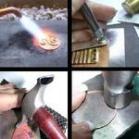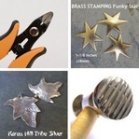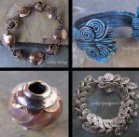Liver of sulfur and brass
by Faina
(Dallas)
Hi Stacy, thanks for taking time....
experimenting for a long time with LOS finishing, found good technique for copper... brass is a different story, ...LOS does not turn my brass black ( that's the result I try to achieve...)...any advice? Will a little Ammonia + LOS help? I do not owe a tumbler at this moment ...thanks a lot.
I am reading your blog for last couple days, very, very practical, educational...a lot of common sense....is there any limitation for hot temperature when you use LOS for copper? How far I can go ....I thought I 'read somewhere when it is too hot LOS loosing its power? True?
Faina.
Stacy's Answer:
Hi Faina!I'm glad you are enjoying my blog!:-) I've found that a near-simmering temperature works really well, especially if you first heat the item to be oxidized in hot water so you don't cool of the LOS solution. I heat the water in a microwave until the first tiny bubbles appear. By the time I remove it and pour it into a container with the LOS, the temperature is perfect!
I've added boiling water to make my LOS solution and it did not affect the LOS. While the LOS's effect was not diminished, extremely hot water can damage gemstones and glass. Be sure to warm them up by submerging them in increasingly hot water BEFORE putting them in the super hot LOS. Rinse them in hot water too as extreme temperature variances can damage glass and gemstones, even annealed glass.
Copper does not need as hot of a solution as silver. If adding a patina to items made of both silver and copper, the hotter solution will darken both metals at a similar rate. A cooler solution will quickly darken the copper, but just sort of make the silver a sickly yellow. Sure you can leave the item in the LOS longer, but then you may start to get a yucky, sludgy build-up on the copper. I prefer to have the metals oxidize quickly and evenly, with no residue and a super hot solution will accomplish that.
I like to add a little ammonia to the LOS to get a blacker black for copper, but LOS and brass? It does about nothing! Try these patina methods for darkening brass. I get more consistent results from the ammonia method below.
Aged Brown Brass Look
1. Pour 1 cup of warm vinegar into a plastic bowl. Add 1 tbsp. salt to the vinegar and stir thoroughly with a plastic spoon until salt is dissolved.
2. Place the brass in the bowl and soak it in the vinegar mixture for about 5-10 minutes.
3. Remove the brass from the bowl and pat the metal dry with paper towels.
4. Place the brass on a dark, non-stick cookie sheet and bake it at 450 degrees Fahrenheit. Watch the brass browning or "aging" as it heats. Remove the brass from the oven when it reaches the desired tint and allow the metal to cool completely.
Another method......
1. Soak the brass in a solution of 1/2 cup ammonia and 1 tablespoons salt for 20 minutes to 1/2 hour.
2. Remove from solution and let dry,
3. Fume the brass over ammonia in a tight-fitting plastic or glass container.
The brass will turn dark brown/black within 10-15 minutes. Remove brass and rinse. You may buff the surface to expose the bright brass highlights. Finish by polishing by hand using a jewelry polishing cloth if you prefer a shiny finish vs. a brushed or matte one.
Be sure to watch the brass as if it's left in too long, you'll get some blue coloring along with the dark brown. This buffs right off with 0000 steel wool or a fine 3M scrubby pad.
Comments for Liver of sulfur and brass
|
||
|
||
|
||
|
||
|
||
















